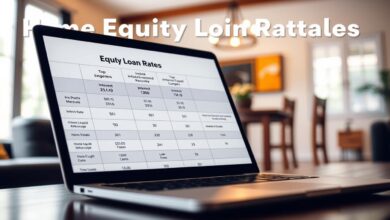College Loans: How to Apply and Get Approved
Pursuing higher education often comes with a hefty price tag. With costs for degrees frequently reaching tens of thousands of dollars, securing financial support becomes a critical step for many learners. Understanding your funding options early can make the difference between stress and confidence as you plan your academic journey.
Government programs and private lenders offer various solutions to help cover tuition, books, and living expenses. Federal aid typically provides lower interest rates and flexible repayment terms, while banking institutions might offer specialized plans for specific needs. Knowing where to start—and what each option requires—is key to building a solid financial strategy.
The application process doesn’t have to feel overwhelming. Simple steps like gathering income documents, researching eligibility criteria, and comparing interest rates can streamline your experience. Preparation ensures you’re not just approved but also receive the best possible terms for your situation.
Key Takeaways
- Higher education costs often require external financial support
- Federal programs and private lenders offer distinct advantages
- Proper documentation improves approval chances
- Interest rates significantly impact long-term repayment
- Early preparation reduces stress during applications
Understanding College Loans
Academic ambitions often meet financial realities that need smart solutions. Funding tools exist to help learners manage costs while focusing on their studies. Let’s explore how these resources work and why they matter.
What Are Student Loans?
Student loans are specialized funds designed to cover education expenses. Unlike scholarships or grants, this borrowed money requires repayment with interest after graduation. They help bridge gaps between savings and tuition fees, making degrees accessible without years of upfront saving.
Eligible learners in programs like the Canada Student Loan Program can receive up to 60% of tuition costs. Full-time and part-time students qualify, with amounts based on financial need and school expenses. Funds often extend beyond classes to cover housing, lab fees, and transportation.
How Loans Support Educational Goals
These financial tools promote equity by serving students from varied economic backgrounds. A single parent studying nursing or a first-gen engineering student might both qualify for support. This system prioritizes potential over current resources.
Repayment terms vary, but federal options typically offer lower rates and flexible schedules. Understanding interest accumulation helps borrowers plan smarter. While grants provide free aid, loans remain vital for many to immediately access education.
Eligibility for Student Loans and Grants
Your chance to get educational funding depends on several key factors. Where you live, your family’s earnings, and special needs all shape what help you might receive. Let’s break down how these pieces fit together.
Determining Your Financial Need
Schools and lenders start by looking at your money situation. They check family income, savings, and school costs. Lower earnings often mean more support. This helps level the playing field for different backgrounds.
Special tools like the federal aid estimator give rough ideas of what you might get. These calculators ask about jobs, dependents, and school expenses. The results show possible loan amounts and grant options.
Key Requirements to Qualify
Each state has its own rules for who gets help. Most require:
- Legal residency in the area
- Enrollment in approved schools
- Passing grades in most classes
Unique cases get extra attention. Students raising kids or managing disabilities often qualify for bigger packages. These adjustments help cover extra costs like childcare or special equipment.
| Factor | Provincial Variation | Funding Impact |
|---|---|---|
| Residency | 1-2 year requirements | Base eligibility |
| Income Level | $0-$150k ranges | 25-100% aid |
| Academic Status | 2.0-3.0 GPA | Continued support |
| Special Needs | Documentation needed | +15-40% grants |
Remember – staying enrolled and keeping decent grades matters. Schools check these every term to keep your funding active. Plan ahead to meet all requirements smoothly.
Navigating the Application Process
Submitting a successful funding request begins with knowing where to start. Many learners find relief in discovering they only need to complete one application for multiple aid types. Provincial systems evaluate your needs while checking eligibility for both grants and low-interest options.
Step-by-Step Application Tips
Begin by gathering your essential paperwork. Recent tax returns, bank statements, and school enrollment letters form the core of most requests. Missing just one document can delay your review by weeks.
- Start 6-8 weeks before your program begins
- Use your province’s online portal for faster processing
- Double-check that all dates and figures match official records
- Contact financial aid services if you hit roadblocks
Documentation and Submission Deadlines
Each region sets unique cutoff dates that impact funding amounts. Ontario students, for example, typically face earlier deadlines than those in Alberta. Late submissions might still get reviewed but often with reduced awards.
“Treat your application like a timed exam – early completion reduces stress and increases success chances,” advises a Manitoba financial aid officer.
| Province/Territory | Key Documents | Submission Window |
|---|---|---|
| Ontario | OSAP forms, SIN, tuition estimate | May 1 – June 30 |
| Alberta | Study permit, residency proof | July 1 – Aug 15 |
| British Columbia | BCID, course schedule | Rolling (8-week lead) |
Set calendar reminders for your area’s deadlines. Many portals allow tracking your application status in real time. Quick responses to follow-up requests keep your request moving smoothly.
Federal College Loans: Options and Benefits
Navigating federal funding options helps learners maximize support while minimizing future debt. The Canada Student Financial Assistance Program simplifies access through combined grant and loan packages. Full-time and part-time students benefit from tailored solutions addressing their unique financial landscapes.
Overview of Federal Loan Programs
The Canada Student Loan Program acts as the government’s primary funding tool. It covers up to 60% of tuition costs based on financial need assessments. This program works alongside provincial aid, creating layered support for textbooks, housing, and other essentials.
Federal options often beat private lenders with:
- Fixed interest rates below 5%
- Grace periods after graduation
- Income-based repayment plans
How Federal Grants Complement Loans
The Canada Student Grants Program delivers non-repayable funds to eligible learners. These awards reduce borrowing needs by covering specific costs upfront. Combined with loans, they create balanced funding packages that address immediate and long-term needs.
| Funding Type | Repayment Required | Average Award | Key Benefit |
|---|---|---|---|
| Federal Loans | Yes | $7,300/year | Low fixed rates |
| Canada Grants | No | $3,000/year | Debt reduction |
| Provincial Aid | Varies | $4,500/year | Local priorities |
Smart applicants use grants to lower their total borrowed amount. This strategy cuts interest costs over time while maintaining full academic access. Government programs reward early applications with optimized funding mixes.
Provincial and Territorial Loan Programs
Canada’s education funding landscape extends beyond national programs, with each region tailoring solutions to local needs. Provincial and territorial initiatives work alongside federal aid to create layered support systems. These programs address unique challenges like remote community access or high-demand career shortages.
Exploring Regional Assistance Options
Every province and territory operates distinct financial aid programs. Alberta’s Learning Information Service helps cover living costs for rural learners, while Quebec’s Aide financière aux études offers enhanced support for technical certifications. These regional options fill gaps when federal limits are reached.
Specialized benefits make these programs valuable. Manitoba Student Aid provides debt relief for graduates working in northern healthcare facilities. British Columbia prioritizes Indigenous learners through culturally responsive grants. Such targeted approaches ensure funds reach those facing the greatest barriers.
“Regional programs adapt to our communities’ evolving needs – whether that’s supporting nurses in Thunder Bay or coders in Vancouver,” notes a Saskatchewan financial aid coordinator.
| Province/Territory | Program Name | Unique Benefit | Application Method |
|---|---|---|---|
| Ontario | OSAP | 30% tuition rebate for middle-income families | Online portal |
| Nova Scotia | Student Assistance | Maritime residency grants | Paper/online hybrid |
| Yukon | Student Financial Assistance | Arctic community travel grants | In-person consultations |
Application processes vary significantly across regions. While Ontario processes requests entirely online, Northwest Territories requires in-person document verification. Many programs now offer mobile-friendly tools and multilingual resources to improve accessibility.
Private Student Loans and Alternative Funding
When federal aid doesn’t cover all expenses, private solutions bridge the gap. Banks and credit unions offer specialized tools for learners needing extra support. These options work alongside government programs to create complete funding strategies.
Understanding Lines of Credit and Home Equity Options
Education-focused lines of credit provide flexible access to funds for tuition, housing, and books. Unlike standard personal loans, they feature lower interest rates and repayment schedules that align with academic breaks. Programs like CIBC’s Education Line of Credit let students borrow up to $150,000 with interest-only payments during studies.
Professional degrees often require larger investments. Banking institutions address this through tailored solutions like the Professional Edge program. Medical, law, and business students can secure higher credit limits based on future earning potential.
| Option | Best For | Key Benefit |
|---|---|---|
| Student Line of Credit | Ongoing expenses | Deferred principal payments |
| Home Equity Financing | Families with property | Rates 2-3% below standard loans |
| Professional Programs | High-cost degrees | Custom repayment timelines |
Homeowners can leverage property value through plans like the Home Power Plan. This approach uses home equity to secure rates often 40% lower than unsecured credit lines. Families save thousands in interest while funding education goals.
Private banking solutions shine through personalized service. Many institutions adjust terms based on career paths or offer grace periods after graduation. Pairing these with government aid creates a safety net for even the most ambitious academic plans.
Improving Your Credit for Loan Approval
Your financial history plays a crucial role in unlocking better funding opportunities. Lenders review credit reports to assess reliability, which directly impacts approval odds and interest rates. Building smart habits early creates advantages that last beyond graduation.
Credit Tips for Prospective Students
Start building your financial reputation before applying for educational funding. Consider these practical steps:
- Open a student credit card with low limits to demonstrate responsible use
- Set up automatic payments for phone bills or streaming services
- Keep credit utilization below 30% of your available limit
“Young adults who establish credit before borrowing often secure rates 1.5% lower than peers,” notes financial advisor Rachel Torres.
| Strategy | Impact | Timeframe |
|---|---|---|
| Student Credit Card | Builds payment history | 6+ months |
| Secured Card | Improves credit mix | 3-12 months |
| Authorized User Status | Boosts credit age | Immediate |
Maintaining a Strong Credit Profile
Regular monitoring helps protect your financial standing. Check reports annually through free services like AnnualCreditReport.com. Dispute errors promptly to keep your profile accurate.
Strong relationships with banking institutions can lead to better terms. Consider keeping a savings account open even with small balances. Lenders appreciate consistent financial behavior over time.
Remember – every on-time payment strengthens your position. These habits not only help secure educational funding but also set the stage for future milestones like car purchases or home ownership.
Comparing College Loans, Student Loans, and Grants
Smart financial planning requires knowing which funding options align with your goals. Free money and borrowed funds serve different purposes, each with unique advantages. Let’s break down how these choices stack up.
Key Distinctions in Support Programs
Gifts like student grants never need repayment, making them ideal for covering essentials like textbooks or lab fees. Borrowed funds, however, add to your future responsibilities. Federal options often provide lower interest rates, while private lenders may offer higher amounts.
Funding limits affect long-term planning. Full-time learners can access aid for up to 6.5 years, with extensions for doctoral programs or disabilities. This impacts students pursuing multiple degrees or career changes.
| Funding Type | Repayment | Max Amount | Key Benefit |
|---|---|---|---|
| Grants | Not required | $4,000/year | Debt-free support |
| Federal Loans | 6-month grace period | $12,500/year | Fixed 4.99% rate |
| Private Options | Immediate interest | Up to cost of attendance | Flexible uses |
The six-month grace period after studies helps graduates transition into work. Use this time to budget for payments. Combining aid types strategically reduces borrowing needs. For example:
- Use grants for tuition gaps
- Choose federal loans for lower rates
- Reserve private options for emergencies
“Mixing grant money with smart borrowing creates a safety net that lasts through graduation,” explains financial aid coordinator Mark Simmons.
Always check if you may be eligible for renewed grants each term. Many students qualify for additional funding as family circumstances change. This approach helps pay for evolving needs without overborrowing.
Conclusion
Smart funding strategies turn academic goals into achievable plans. By combining government programs, regional support, and private solutions, learners create financial safety nets that last through graduation. Understanding eligibility rules and application timelines helps secure the best possible mix of grants and low-interest options.
Start early to maximize free aid like student grants. These funds reduce borrowing needs while covering essentials like books and lab fees. Pair them with federal programs for their flexible repayment terms and interest rate advantages.
Every student’s path differs. Some benefit from provincial aid targeting local workforce needs, while others use banking services for specialized degree costs. Consult financial aid offices to explore combinations that fit your situation.
Remember – organized applications and credit awareness open doors to better terms. Education remains within reach when you strategically layer funding sources. Your future self will thank you for the planning done today.









